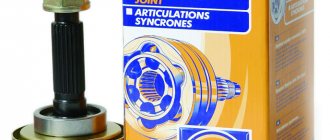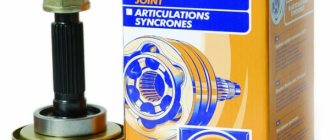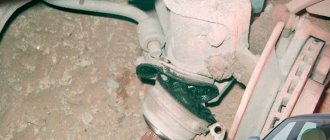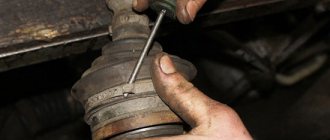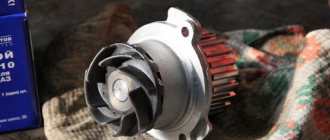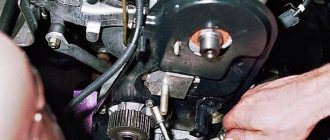Cars with front-wheel drive have a shaft with two grenades, through which torque is transmitted from the gearbox to the wheels. The mechanism tends to wear out, and it may be necessary to replace the outer CV joint on a VAZ 2114. The repair does not require special knowledge from the car owner who decided to service the car himself, and following the instructions for replacing the outer CV joint on a VAZ 2114 with your own hands, you can do it correctly.
This video clearly shows the process of replacing the internal grenade:
Symptoms of outer CV joint failure
Signs of mechanism failure are similar to an internal grenade:
- Crunch . While driving, turning the wheels and pressing hard on the gas, you will hear a distinct crunching sound in the front axle area. A common problem with outer CV joint failure is a torn boot during operation. If there is a suspicion of a malfunction, to diagnose it, just turn the wheel out and look behind it. When the rubber band covering the moving part breaks, dust and dirt begin to get into the mechanism. Because of this, the lubricant thickens and loses its properties, while acting as an abrasive and increasing production on the balls inside the part.
- Backlash . This also happens due to the development of the mechanism. In this case, vibration will be felt on the body when the car moves. To be sure of the problem, you need to grab the drive and swing it in different directions. If play is felt, it means the part is broken.
Remember that it is extremely unsafe to continue driving in such situations. You can damage your car by increasing the cost of repairs. It’s better to go to the nearest service center or call a tow truck.
Replacement results
Failure to replace the boot in a timely manner will result in the “grenade” breaking, which in turn will make it impossible to use the car. Regular inspection of boots and CV joints will prevent dirt from getting into the part.
If you find breaks in the boot, you should purchase new ones and install them. When replacing boots, you should inspect the CV joint to make sure it is in good condition. This will not take much time, but will preserve the integrity of the CV joint and save money.
If you nevertheless looked at the cracks and tears in the protective case and did not have time to replace it at the initial stage, but realized the problem from the characteristic sounds, then it is necessary to replace the damaged “grenade” as soon as possible. After the repair has been carried out, it is recommended to check the car; to do this, you need to drive it in a circle and accelerate a little on a straight road. The absence of creaking and tapping sounds is a sign of correct installation.
Necessary tool
If you decide to do the repairs yourself, you will need the following tools to disassemble the car:
- Open-end wrenches for 17, 19. But it is better to have a full set on hand;
- Set of heads and knobs;
- Wheelbrace and jack;
- Pliers;
- Screwdriver;
- Hammer;
- Rag and gloves.
Useful : How to replace the internal grenade on a VAZ 2114?
Also make sure you have a complete replacement kit: grenade, boot, CV joint grease and two clamps. For convenience, you can drive onto a pit or overpass, and for safety reasons, set the car to the parking brake and put supports under the wheels.
Location
It will be impossible to replace the CV joint on a VAZ 2114 if you do not know where exactly these elements are located. Their location is easy to determine - on both sides of the front suspension at the bottom of the car. They are oblong elements and fit into the hub of each wheel.
CV joint location
That is, getting to the node is not difficult, but this will require certain conditions.
The most important thing is that the replacement procedure is not complicated, which allows you to do the work yourself. But let’s say right away that if you don’t have the time, desire, or are simply not confident in your own skills, it’s better to entrust the repair to specialists. You will spend extra money on this, but you will be sure of the result.
The process of replacing the outer CV joint
Having prepared everything you need, you can figure out how to replace the outer CV joint. This is done according to the following points:
- Remove the decorative cover (if any) from the car disk and flare the hub bearing nut.
- We take a 30mm socket, a wrench and preferably an extension to provide greater leverage. We take off the nut.
- Jack up the car and remove the front wheel.
- For convenience, unscrew the brake caliper. This is done with a 17 key. The bolts are located on the back of the hub.
- We spread the pads with a screwdriver and remove the caliper along with the bracket securing it to the hub.
- To press out the steering tip, we need to unscrew the nut with a 19mm wrench, and then apply force to knock it up.
- We unscrew the two 17mm bolts that secure the ball joint.
- Now you can completely unscrew the hub nut.
- We pull the hub towards ourselves, removing the CV joint from it.
- Many car enthusiasts carry out the replacement process without removing the drive from the car. But if you are doing this in the garage, then for convenience it is better to remove it and move it to the workbench. If you have removed the drive from the box, plug the hole with a rag to prevent excess oil from leaking out.
- If the grenade boot is not torn, then use pliers to unclench the large clamp and, prying it up with a screwdriver, remove it.
- We carry out a similar process with a small clamp and move the cover down.
- We begin to knock down the old part with a hammer. Hit on different sides to remove the CV joint evenly.
- We clean the drive splines from grease to see the retaining rings.
- We replace the old ring with a new one, which comes with the grenade.
- We fill approximately 80 cm3 of lubricant into the CV joint cavity and install it on the drive. It is better to do this through a drift made of soft metals or through a block. This will help prevent damage to the new part.
- We install a new boot and place the clamps. Replacing the grenade boot is required in all cases of repair, even if the old one has slight wear. The fastener of each should be directed against the direction of the vehicle. Then we crimp them with pliers.
At this point, the repair process is completed and the entire chassis can be assembled in the reverse order.
Internal CV joint device
The internal constant velocity joint is designed to transmit torque from the transmission to the outer CV joint. It differs from the external one in size (increasingly) and cost, although it consists of the same parts:
- Bowl-shaped housings with a driven shaft.
- The inner race is a spherical fist with a drive shaft.
- A separator in the form of a ring with holes to hold the balls.
- Metal balls.
The roller type of hinge is characterized by the presence of a support, which, using three rollers, moves along tracks cut into the inside of the body. The balls or rollers are located in the grooves of the housing and are held by a cage, which is connected to the drive shaft by a splined joint. When the angle of the drive and driven shafts changes, the balls move along the grooves, continuously transmitting force.
Cost of outer CV joint
If you are faced with the task of choosing a new part, it is best to choose a product from the manufacturer, that is, choose a genuine spare part. Most often, they have a price slightly higher than analogue ones, but are distinguished by excellent product quality.
But check the article number, as some auto stores may sell you a Chinese part with a box that is very similar to the original. The part should go under the number 21080-2215012-86. The price of the set will be about 1400 rubles .
If you want to purchase analog parts, then after reading the reviews, you can identify three quality companies:
- HOLA – 1200 rubles;
- GKN – 1600 rubles;
- KRAFT – 1150 rubles.
Before purchasing, it is best to study the reviews of the store where you want to purchase the part. This way you will be completely sure that you are buying a quality spare part. And in this article we presented prices for internal grenades of the VAZ 2114 from 10 manufacturers.
Which brand of grenade should I choose?
When searching for components, you should approach their selection with care. The CV joint is the main part of the car's drive and often fails, so you should choose a spare part not only for reasons of price, but also quality.
Useful : Replacing the external grenade of a VAZ 2114
It’s better to find the original; look carefully at the box in which the CV joint is sold, as you can often find a very high-quality fake. Also pay attention to the part number, it should be 2108-2215056 . The average price is about 2000 rubles .
When considering certified analog spare parts for purchase, you should look at the quality of workmanship. Even reading most of the positive reviews about a particular brand, you should not exclude the percentage of defects, which always exists.
Cost of replacement at a car service center
If you do not want to do the repairs yourself, you can contact a car service in your city. Prices for repair work can range from 800 to 1,500 rubles, if we consider the average prices in Russia.
If you are limited in finances and want to save almost half of the repair budget, changing the external CV joint on a VAZ 2114 yourself is not so difficult. But in any case, approach the choice of spare parts carefully, since if you buy a part that is obviously not of high quality, you may again encounter the problem of a worn grenade in the near future. Try to check the condition of the anthers at least once a month, this will help extend the life of the mechanism. You will have time to replace the outer CV joint boot in time and the mechanism will not have time to become dirty. Well, if the connection is severely worn out and begins to make extraneous sounds, it is better to begin repairs immediately, otherwise you may create a threat to other road users.
How to change the CV joint on a VAZ 2114
Replacing CV joints on VAZ 2115, VAZ 2114, VAZ 2113
In front-wheel drive cars, one of the most problematic areas is the constant velocity joints. Abbreviated as CV joint or "grenade". The CV joint is a kind of ball bearing; its races have transverse grooves, which allows you to change the angle between the drive and driven axle shafts. All elements of the CV joint are made of ultra-strong alloys, the wear of which occurs extremely slowly, but, as practice shows, signs of a CV joint malfunction can appear even in a car that has recently left the assembly line of a car plant.
On cars of the VAZ family, it often becomes unusable after
55,000 km .
Causes and symptoms of CV joint failure on a VAZ 2115
The most common reasons:
- low quality CV joints, installation of fakes or defective spare parts;
- lack or poor quality of lubricants;
- damage to the boot and entry of abrasive debris or water into the mechanism;
- aggressive driving style and disgusting condition of the road surface.
One of the signs of replacing a VAZ 2114 CV joint is the appearance of a characteristic “crunch” . This sound can only be produced by balls that roll along grooves, because... have too much output. Working in close contact under constant load inevitably leads to changes in the properties of rubbing parts, their sizes, and the formation of wear.
Where there is no close contact of these elements and extraneous noise appears. The sound can appear at any time, but usually it occurs when turning, sharp acceleration, or overcoming obstacles. There are other signs indicating a hinge failure :
- slight jerks when starting the car or changing dynamics;
- play of the shaft located between the CV joints when trying to move it in different planes.
Symptoms of a problem
The operation of a CV joint is always associated with the impact of enormous loads. Despite the use of high-strength materials in the design of the unit, it can sometimes fail. The following reasons contribute to this:
- Use of low quality materials in the manufacture of assembly parts, use of counterfeit or defective spare parts.
- Lack of lubricant inside the mechanism or its poor quality.
- Water or abrasive debris getting inside the mechanism due to damage to the boot.
- Excessive load on the mechanism due to poor road conditions or aggressive driving style.
- Long-term operation, during which the life of the parts is exhausted.
What lubricant to use for CV joints
The main tasks of lubricants used in CV joints are protection against friction and prevention of corrosion. Also, the lubricant must be inert with respect to the polymer boots, which prevent moisture and debris from entering the mechanism. Most of the above requirements meet the following types of lubricants:
1. Lithium. These are viscous yellowish compounds, which at low temperatures acquire an even thicker consistency, making it difficult to spread on parts. They are able to significantly reduce friction and loads acting on the hinge elements, protect them from moisture and neutralize accidentally trapped dirt. Their only drawback is the ability to dissolve some types of anthers made from organic polymers. One of the representatives of this type of lubricant is the domestic Litol-24, which is replaced after a run of 100 thousand km.
2. Based on molybdenum disulfide. More universal lubricants that are characterized by increased resistance to corrosion. Their composition has a reduced content of organic acids, thereby reducing aggressiveness towards polymer products. Such lubricants are recommended for use in CV joints of cars of any manufacturer. Their main drawback is sensitivity to moisture ingress when the seal of the boot is broken, due to which the lubricant loses its properties. Domestic manufacturers produce lubricants with molybdenum disulfide under the general name SHRUS-4.
3. Barium grease. It is resistant to moisture getting inside the mechanism, successfully resists corrosion, and is also neutral to any polymers from which the anthers are made. Its main drawback is poor resistance to low temperatures. Lubrication is currently not very common due to its high cost. All domestic compounds manufactured using this technology are labeled under the name ShRB-4.
